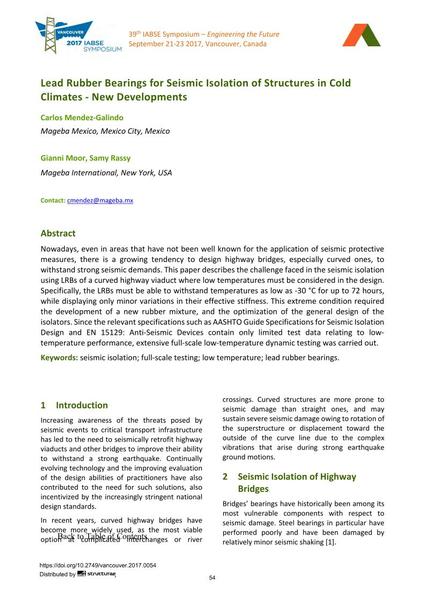Lead Rubber Bearings for Seismic Isolation of Structures in Cold Climates - New Developments

|
|
|||||||||||
Bibliografische Angaben
| Autor(en): |
Carlos Mendez-Galindo
(Mageba Mexico, Mexico City, Mexico)
Gianni Moor (Mageba International, New York, USA) Samy Rassy (Mageba International, New York, USA) |
||||
|---|---|---|---|---|---|
| Medium: | Tagungsbeitrag | ||||
| Sprache(n): | Englisch | ||||
| Tagung: | IABSE Symposium: Engineering the Future, Vancouver, Canada, 21-23 September 2017 | ||||
| Veröffentlicht in: | IABSE Symposium Vancouver 2017 | ||||
|
|||||
| Seite(n): | 54-63 | ||||
| Anzahl der Seiten (im PDF): | 10 | ||||
| Jahr: | 2017 | ||||
| DOI: | 10.2749/vancouver.2017.0054 | ||||
| Abstrakt: |
Nowadays, even in areas that have not been well known for the application of seismic protective measures, there is a growing tendency to design highway bridges, especially curved ones, to withstand strong seismic demands. This paper describes the challenge faced in the seismic isolation using LRBs of a curved highway viaduct where low temperatures must be considered in the design. Specifically, the LRBs must be able to withstand temperatures as low as -30 °C for up to 72 hours, while displaying only minor variations in their effective stiffness. This extreme condition required the development of a new rubber mixture, and the optimization of the general design of the isolators. Since the relevant specifications such as AASHTO Guide Specifications for Seismic Isolation Design and EN 15129: Anti-Seismic Devices contain only limited test data relating to low- temperature performance, extensive full-scale low-temperature dynamic testing was carried out. |
||||
| Stichwörter: |
Seismische Isolierung tiefe Temperatur
|
||||
